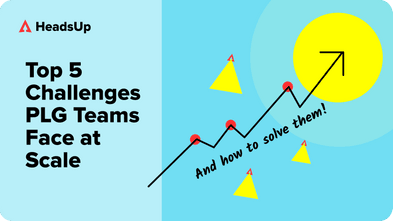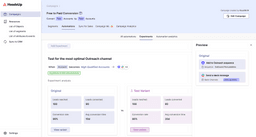The best PLG teams are constantly experimenting with new Product Qualified Lead models, measuring their performance, and optimizing outreach channels with the help of product usage data.
But scaling go-to-market teams can’t do this without a ton of operational alignment.
More sales and marketing horsepower can be a benefit when trying to work more leads, but it’s a major source of friction when launching monetization experiments.
If you want to be able to test product-led segments and engagement motions, there are ways to move fast.
After speaking to hundreds of PLG companies, we’ve uncovered the top challenges that scaling go-to-market teams are dealing with right now—and how to resolve them.
Challenge #1: Inaccurate PQLs causing low conversions
The critical task growth and revenue leaders in scaling PLG teams face is figuring out the optimal threshold of usage before a lead is flagged as a PQL and routed to sales or other outreach channels.
Many product-led companies we’ve spoken to struggle to get PQLs and other qualification models right.
Most companies successfully convert only ~5% of leads to paid. Compare that to top performing teams in PLG superstars like Atlassian, Zoom, Slack, and Dropbox – which convert 25% of all leads from their free user base.
One reason for this is that many PQL models fall short in one of two ways. Either they are so inaccurate as to flag many ‘false positive’ leads, leading to really low conversion rates, or, they flag good opportunities – but too few of them. In the second instance, growth teams default to relaxing PQL criteria to increase lead volume at the expense of quality.
At the heart of this challenge lies a fundamental problem with “rule-based” PQL approaches that many companies use. These consist of defining a few specific trigger conditions that usually take the form of “user has performed X activity Y times.” Conditions tend to be created on the basis of intuition and rudimentary analysis — which are often one-off and do not evolve with changes in customer profiles, use cases, product features, and seasonal norms of usage.
How to fix it
To address the issue, you’ll want a more sophisticated PQL discovery process, such as a pairwise comparison matrix that can be used to compute the relative priorities of criteria in real-time.
“We made a pairwise matrix to see which variables are most correlated with other variables,” says Chris Reuter, Head of Growth at Prefect. “It tells us how much people are engaging with the product, and once the activation score hits a certain hurdle, they’re classified as a PQL and we look at potentially engaging with them.”
Or, if you have access to data science resources, you may want to invest in building out a predictive model that takes into account all your different usage events along with firmographics and demographics to score leads for conversion likelihood, based on historical closed/won data.
How HeadsUp can help
Fortunately, you don’t have to build your own model. HeadsUp uses Machine Learning to identify PQLs. Our product models historical conversions against usage patterns and then uses that scoring model to predict the probability of each account converting.
Check out this 3-minute demo of our Machine Learning PQL modeling.
Challenge #2: Sellers not knowing WHY an account is a PQL
Another struggle that enterprise and scaleup PLG companies face is letting sellers know why an account has been flagged as a PQL.
Let’s say you sell a webinar or live event platform. You might have one user who spent two hours setting up their company’s branding, team members, and other global settings. Meanwhile another user spent an hour creating an event, adding the speaker, uploading the slides, and customizing the notification emails to registrants.
Both users are PQLs but for different reasons.
When sellers are blind to those key usage events, they can’t effectively customize talk tracks, and may, in the best case, waste time on discovery with leads, and at worst, have outreach misfire because leads are caught off guard by ‘proactive’ outreach.
How to fix it
The solution here is to make sure sellers know why someone is a PQL. To do this, you’ll need a reliable way to identify key usage events and surface activity metrics to sellers. You could use an rETL tool to sync these to Salesforce as attributes.
Alternatively, we’ve seen some teams build a custom looker dashboard and embed it in Salesforce.
You could also have your analyst export the data from your data warehouse through SQL queries, or from your product analytics tool as a spreadsheet, and teach sellers how to decode it.
All of these options require no small amount of engineering effort and sales enablement training.
How HeadsUp can help
The best possible way to handle this is to bring relevant insights on usage and other key account attributes directly into Salesforce for sellers.
Inside of Salesforce, sellers should be able to see top usage activities that caused an account to be flagged as a PQL, and other relevant insights on power users, decision makers, and recent activity that informs an effective talk track for outreach.
This way, sellers will not only know exactly why an account is a PQL, but they’ll also be able to identify the most effective target individual and messaging to close the deal with. The more complex your tool is, the more powerful such insights could be for sellers.
HeadsUp helps you push key context on PQLs, usage trends, and power users directly into a custom Salesforce extension.
Check out this 2-minute demo video of what this data looks like inside of Salesforce.
Challenge #3: Suboptimal outreach reduces revenue efficiency and results in poorer CX
Some scaling revenue teams funnel most of their PQLs to sellers, assuming this to be the best way of driving conversion.
But sometimes, users aren’t ready to get on a call, resulting in misfires. Or, accounts happily get on a call with sales reps, but in fact would have upgraded self-serve if that option was made available to them.
Not finding the optimal channel and timing for outreach could result in highly inefficient growth – with unhealthy CAC:LTV ratios. Moreover, if outreach is not coordinated properly across marketing, sales, and in-product nudges, customer experience may be compromised, hurting retention & NPS.
How to fix it
To fix it, you need to first identify the most optimal outreach channel for different PQL segments and their stage in the customer journey. For each PQL segment and journey stage you create, try routing one to sales and another to marketing, or in-product hooks, and compare the conversion rates and time-to-upgrade for the different channels.
Then, create a system that orchestrates and monitors outreach across all the different channels to give you visibility into who’s touching what leads, and ensure that customers only receive outreach from the most effective channel.
How HeadsUp can help
Running these sorts of A/B tests requires a lot of effort. With HeadsUp, you can spin up new experiments across multiple channels in a matter of minutes.
Challenge #4: Low sales productivity due to context switching in PQL workflows
Growth teams at scaling PLG companies are constantly experimenting with new monetization initiatives, as they should. But those experiments typically involve change in seller workflows.
To access lists of PQLs, for instance, sellers often have to leave their familiar interfaces like Slack and Salesforce, and go into a dashboard or spreadsheet to pull relevant information.
But sellers are most productive in Salesforce—not spreadsheets or data dashboards.
All of this means seller productivity takes a hit. It takes reps longer to decide who they should call, and what they should say to leads flagged by these experimental PQL models.
Increasingly, we see the emergence of “PLG CRMs” that aim to make it easier for sellers to engage leads in product-led motions. But in reality, large teams have to juggle the new surfaces that these alternative CRMs introduce alongside Salesforce, which they’ve already implemented.
Lower productivity means a lower volume of calls. So even if the team is getting higher quality, leads, the amount of time it takes to discover and contact them can ultimately reduce total conversions and revenue closed.
How to fix it
To address this, you’ll need to push PQL data directly into Salesforce so sellers can spend just a matter of minutes finding out which accounts have been flagged as PQLs, and get relevant context to customize outreach.
You can use a rETL tool to sync PQL markers and some key usage attributes into Salesforce, but limitations of Salesforce mean sellers will be unable to see an activity timeline, power users, and most importantly the exact reasons why an account was flagged as a PQL.
How HeadsUp can help
The HeadsUp Salesforce extension doesn’t require sellers to learn a new tool. Instead, they can keep their same Salesforce workflows and add product activity insights for smarter prioritization and outreach.
Challenge #5: Slow monetization experiments
Anyone in a revenue team knows that the more people required to launch a monetization experiment, the longer it will take to actually push the start button.
Growth teams want to continuously improve various conversion, monetization, and revenue efficiency metrics. To do this, they need to test their lead scoring and engagement methods without having to coordinate a dozen team members across marketing and sales.
There are a few different issues within this challenge:
- Data science – Growth experiments are data-science intensive, requiring dedicated full-time data scientists and analysts on board.
- Alignment – A ton of changes to sales operations are required when it comes to aligning on new workflows, from who touches what leads to how sellers even get assigned PQLs and what the PQL outreach playbook is. Everything requires new processes and training.
- Measurement – Measuring the results of these experiments against meaningful revenue and success metrics is just as challenging. Teams need an analyst to write SQL queries and quantify the impact and prove results to executive stakeholders.
All of this complexity means that it takes months to execute each experiment. The larger your PLG revenue team gets, the longer it will take to test anything because there are more people to coordinate.
How to fix it
There’s really only one way to address this problem – and it requires a significant innovation in the tech stack your growth team uses.
What growth teams really need is an end-to-end experimental platform that helps accelerate data science modeling, deployment of experiments into existing GTM workflows, and measure impact against key success metrics, with minimal technical resourcing.
How HeadsUp can help
With HeadsUp, revenue teams can create new data science models from usage data and other account metrics in a matter of minutes. Without any additional engineering effort, lead scoring models can be deployed into existing tooling like Salesforce, Outreach, and Marketo so no alignment or training around new workflows is required.
Here are the key benefits of using an end-to-end solution like HeadsUp:
- PLG teams can build new PQL or other lead qualification models with Machine Learning in a few clicks without help from a data scientist.
- PQLs are pushed into workflows in Salesforce, Marketo and Outreach. Sellers get PQLs and relevant contextual insights directly in their CRM and browser — no context switching or training required.
- Growth experiments and iterations on existing models can be deployed instantly within existing workflows, with minimal operational alignment.
- Impact of experiments are automatically quantified against key revenue metrics by plugging into closed/won, contract value and other data points from your CRM and billing systems. No SQL queries needed.
Help your revenue team experiment faster and you’ll see the results for yourself.



